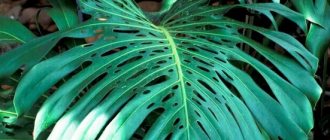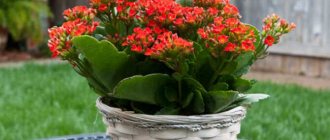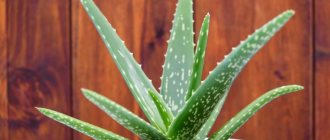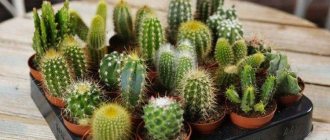Maranta does not need spectacular inflorescences; it is beautiful without them. Its variegated, patterned leaves have delighted gardeners for over 400 years. Marantophiles never tire of being amazed by the touching habit of this delicate flower - folding its leaves in the evening, as if reading a prayer. Seeing this “gesture,” the British called arrowroot a prayer plant and attributed mystical properties to it. South American Indians also have legends associated with arrowroot. No matter what continent the fans of this whimsical plant live on, they are convinced that the whims of arrowroot are worth fulfilling in order to admire the magically colored leaves that are so similar to the feathers of strange birds. Below we will tell you about the features of caring for this unusual plant at home.
Photo gallery
What kind of soil is needed?
Light, nutritious, breathable soil is considered suitable for arrowroot. The choice of ready-made store-bought mixtures is quite wide, but when purchasing, choose only those that were originally intended for arrowroot. This will be indicated on the packaging. Pay attention to the composition, which should contain leaf/turf soil, peat, humus and mineral complexes.
Among the disadvantages of the ready-made mixture, it can be noted that the substrate in its pure form still does not meet the requirements and requires additional additives - most often these are spruce needles, sphagnum and peat. Before planting, it is advisable to check the acidity of the substrate: the pH level should not exceed 6.0.
The soil needed for arrowroot is very easy to prepare yourself. The simplest option is a mixture of soil, peat and sand in proportions 3:2:1. Experienced gardeners advise, if possible, to add either sphagnum moss or crushed charcoal. The soil mixture should be quite loose. Pebbles, expanded clay, shards or coarse sand are suitable for drainage.
Transfer
Young specimens of arrowroot require replanting every year, and adults once every 3-4 years. It is better to do this after pruning, when all the shoots are cut off. The pot for arrowroot must be made of plastic or clay, covered with glaze, 2-3 cm larger than the previous one. Drainage in the form of pebbles or expanded clay, as well as holes for water drainage, are required.
The soil for arrowroot should be loose, soft and light. You can buy ready-made soil for arrowroot in the store, or you can prepare the soil mixture yourself. To do this, use the following ingredients:
- 3 parts leaf soil;
- 1.5 parts peat;
- 1 part each of coniferous soil, sand and dry mullein;
- 0.3 parts ash.
Transplantation is carried out by transferring a clod of earth from one pot to another. To quickly root and retain moisture, the pot can be temporarily covered with film. In the first month after transplantation, arrowroot does not need to be fertilized.
Reproduction
Can be propagated by cuttings or division. It is best to propagate by cuttings from May to the end of August. To do this, the best way is to cut the tops of new shoots with 2-3 healthy internodes.
Place them in water, and after 4-5 weeks, when the roots reach 3 cm in length, the plants can be planted in a shallow pot. After planting for rooting, provide the arrowroot with a greenhouse effect by covering the pot with film.
Propagation by division is best done in the spring when transplanting the plant into another pot or changing the soil. Sterilize the knife and cut the bush so that each part remains completely viable. To do this, leave part of the roots and a growing point for each division.
Before placing the separated parts in the pot, do not forget to sprinkle crushed coal on the cut roots of each.
In this case, the plant will also need a greenhouse effect, so water the seedlings and cover them with a plastic bag or film.
Possible problems
If you do not care for the arrowroot correctly or do not provide it with suitable conditions, then problems may begin with it:
- The tips of the leaves dry out. If the air in the room is too dry, then the tops of the leaves turn brown and dry out, they even sometimes fall off. Also, due to low humidity, the growth of the bush may become slower.
- Rot has appeared . If in winter the plant is watered excessively or it is kept in the cold, then its shoots may lose turgor, and rot may also form on them.
- Spots on foliage . If a flower feels a lack of moisture, then spots form on its leaf plates, they begin to curl, and yellowing of the lower foliage is also observed.
- The bush becomes faded . The plant reacts extremely negatively to direct sunlight, which causes the leaves to lose their spectacular color and dry out.
- Harmful insects . The greatest danger to him is represented by spider mites.
Fertilizer and feeding
Arrowroot needs mineral and organic fertilizers; it reacts sharply to the slightest excess feeding. Experienced flower growers recommend diluting all fertilizers with 2 times the amount of water specified in the instructions.
Fertilizing is relevant during the period of active growth - from the beginning of spring to the beginning of autumn. Organic and mineral fertilizers must be alternated and the soil must be fertilized once every 2 weeks. Pokon, Bona Forte and Agricola formulations have received many positive reviews.
Ordinary ash has the properties of organic fertilizer. It can be used to flavor the soil either in dry form or in a solution of 1 tablespoon of ash with 1 liter of clean, settled water.
But the mixture must first be kept for 24 hours and only then the substrate must be watered.
Useful qualities
Arrowroot flour is made from the tubers of the plant. This dietary product treats anemia and anorexia. It contains no proteins and fats, but is high in fiber and ash. The composition also includes folic acid, vitamins PP and B9, calcium. The product has a general strengthening effect, promoting:
- removing toxins from the body;
- lowering blood sugar;
- normalization of sleep;
- improving brain activity.
This natural thickener is an analogue of corn and potato starch and should definitely be included in the family diet. Contraindications for use include individual intolerance, stomach ulcers, and surgical interventions.
Maranta's photos demonstrate her stunning decorativeness, enlivening any interior with its beauty. In addition, there is an opinion that it suppresses negative energy, preventing quarrels and conflict situations in the family.
A non-trivial flower, the sign of Aquarius is the choice of creative, active people. It is a symbol of prosperity, and its flourishing promises monetary profit. In England, a pot with an outlandish bush is a mandatory attribute of virtually every home, called the “10 Commandments.”
Watering
For irrigation you will need clean soft water up to 5 °C above room temperature. In summer, the flower needs increased moisture, and it should be watered at least once every 48 hours. In this case, it is necessary to control the general level of humidity of the substrate so that the roots do not rot.
For additional moisture, initially place the arrowroot on a tray filled with gravel or expanded clay filled with water.
In winter, water the flower no more than 1-2 times a week, depending on the degree of dry air caused by the heating season.
How to organize watering during a long absence?
The lack of necessary moisture leads to rapid drying out of the arrowroot. If you are going on vacation, make sure in advance that the flower has access to a source of moisture. To do this, you can use 3 options:
- Place wet sphagnum moss on the surface of the substrate. This will help retain moisture in the roots.
- Place a layer of expanded clay, pebbles or sand in a drainage pan and fill everything with water. Place the arrowroot on top so that the bottom of the pot does not directly touch the water.
- If possible, place the plant in a florarium.
Description of the plant
Arrowroot is a herbaceous perennial. The homeland of this plant is the swampy tropics of America. The name is associated with the name of the scientist B. Maranta.
In the wild, arrowroot is a small plant, about 20 cm in height, with straight or creeping shoots. The leaves, depending on the type, are lanceolate, round or oblong. Against a smooth background (its color can be different - from very light to dark green), spots and veins stand out clearly.
Spots and veins stand out brightly against the even background of arrowroot leaves.
Arrowroot is often confused with its relative Calathea. However, these plants have obvious differences. Calathea is taller (from 60 cm to 1 m), with long delicate leaves. They, unlike arrowroot leaves, are arranged on the petioles in two rows. In addition, arrowroot flowers are inconspicuous, while calathea flowers are spectacular and bright.
The leaves of arrowroot are so unusual and beautiful that this plant is bred precisely because of their decorative properties. The plant is unpretentious in care and adapts well to home or office conditions, in open and closed florariums.
The peculiarity of arrowroot is that when the plant feels good, it places the leaves horizontally, but under unfavorable conditions (especially in low light), the leaves fold and rise vertically. For this reason, the plant was nicknamed “praying grass.”
Diseases
There are no specific diseases unique to the arrowroot family. All problems are caused by simple carelessness of the owner or failure to comply with mandatory care conditions.
Any ailment of the arrowroot will be clearly demonstrated by its appearance. There is a high probability that growth will stop. All this is provoked by three main reasons: root rotting, insect damage and insufficient air humidity.
The fact that rotting has occurred in the root system can be recognized by wilted leaves in wet soil. Most likely, the flower suffers from low temperatures due to abundant watering or poor-quality soil. To eliminate the problem, it is necessary to dry the soil, eliminate the affected areas and establish a proper watering regime. In some cases, it makes sense to transplant the arrowroot into a new sterilized substrate.
Types of arrowroot
- Tricolor (tricolor). This is a plant with dark green leaves edged with a paler color. There are light green streaks running down the center. The dark red veins become darker towards the edges. Tricolor arrowroot is the most unpretentious and widespread type of this plant.
- White veined (Fascinator). The leaves are oval, reaching a length of 15 cm. Features: on the dark green leaves there is a silver stripe running down the center. Along with the tricolor, it is unpretentious.
- Arrowroot two-color. Quite a rare species with dark green leaves, on which light specks are scattered.
- Reed arrowroot. This plant can reach a height of 1 m. The leaves are oval, elongated, and have a gray tint.
Varieties in the photo
White vein has another name - Fascinator
Tricolor arrowroot is the most common type for home growing.
Reed arrowroot can grow up to 1 m
Two-color arrowroot is rare
Pests
There are two dangerous pests for arrowroot - scale insects and spider mites.
Shchitovka
A very small insect, up to 5 mm in size, with a waxy shield that completely covers its body. Appears on the flower if care is not accompanied by regular air humidification; it feeds on arrowroot juice.
Affected leaves can be easily identified by raised bumps or plaques of green, brown or yellow color on the outside or inside. If the arrowroot is infected quite recently, and the scale insect is not yet visible to the naked eye, it can be detected by the sticky secretion on the flower that it leaves.
Insect control is carried out using a soap solution and insecticides. Using a cotton swab dipped in soapy water, thoroughly wipe the leaves to remove adult insects.
The same can be done using Karbofos solution. After this, spray the flower with one of the following products: Aktara, Bankol, Mospilan, Actellik or their analogues. At the same time, do not forget to treat the surface on which the flower stands.
If the arrowroot is on the windowsill, even the nearest window glass must be treated.
Spider mite
Microscopic arthropod insect. Infected leaves are distinguished by small yellow dots, which subsequently merge into one large spot. The mite appears due to dry air; in some cases, the cause is called, on the contrary, excessive humidity. At the same time, the tick can be brought into the apartment already on the leaves of an infected arrowroot, in a purchased substrate, or in the soil from the street.
Get rid of the pest by wiping the leaves and stem with soapy water and acaricides. Among the most effective are Vertimek, Akarin, Neoron, Fitoverm and Actellik.
To prevent scale insects and spider mites, do not forget to systematically moisten the room where the flower is located. Do not place any purchased cut bouquets next to arrowroot. And keep all new purchased plants in a 3-week quarantine in another room.
Varietal diversity
When growing at home, they often use:
- The most popular three-colored species has a contrast of central and lateral reddish veins on a leaflet resembling a fish ridge in appearance, and a crimson underside.
- A two-color type with a striped top and a pubescent bottom with wavy leaves at the edges.
- Reed giantess over 100 cm in size with pointed foliage with fluff.
- Kerkhovena or “Rabbit's Foot” is a low-growing perennial with leaf spots that look like eyes and feathers; at the bottom the red color turns into blue.
- Miniature Massanja with brownish-olive spots.
- A white-veined subspecies with white veins.
Morantha flowers - white, cream, lilac inflorescences in the form of a spike cannot be called spectacular; they are usually removed, preserving the maternal powers and not using the seeds to obtain new samples.
Errors when leaving
Any deviation from the rules for maintaining arrowroot is immediately reflected in the condition of its leaves. They curl, dry out or turn yellow. The flower suffers from certain mistakes of novice gardeners, and the most common of them are:
- unacceptably dry air;
- insufficient soil moisture;
- too heavy, unsuitable soil;
- the flower is exposed to the negative influence of direct sunlight;
- the flower is in a draft;
- the air temperature has dropped below the permissible 17 °C;
- arrowroot is affected by insects in a neglected form.
Maranta will enliven and decorate any interior. If you don’t already have such a flower, you can purchase or order it from flower shops. The cost depends on the type of plant, region and place of sale, and ranges from 150 to 900 rubles.
Specific features
In the natural environment, the culture grows in the swampy and forested areas of America. These are small specimens with a tuberous root up to 30 cm high, but there are also giants up to 2 meters. From the description of the flower, it is clear that its popularity is due to its decorative leaves, which have an elliptical or oval-round configuration and an unusually interesting coloring, including all transitions of green and even a red-black tint.
Due to the unusual ability of the leaf blades to change their position in the evenings, rising upward and folding in the shape of folded hands, it received the name “praying grass.”











